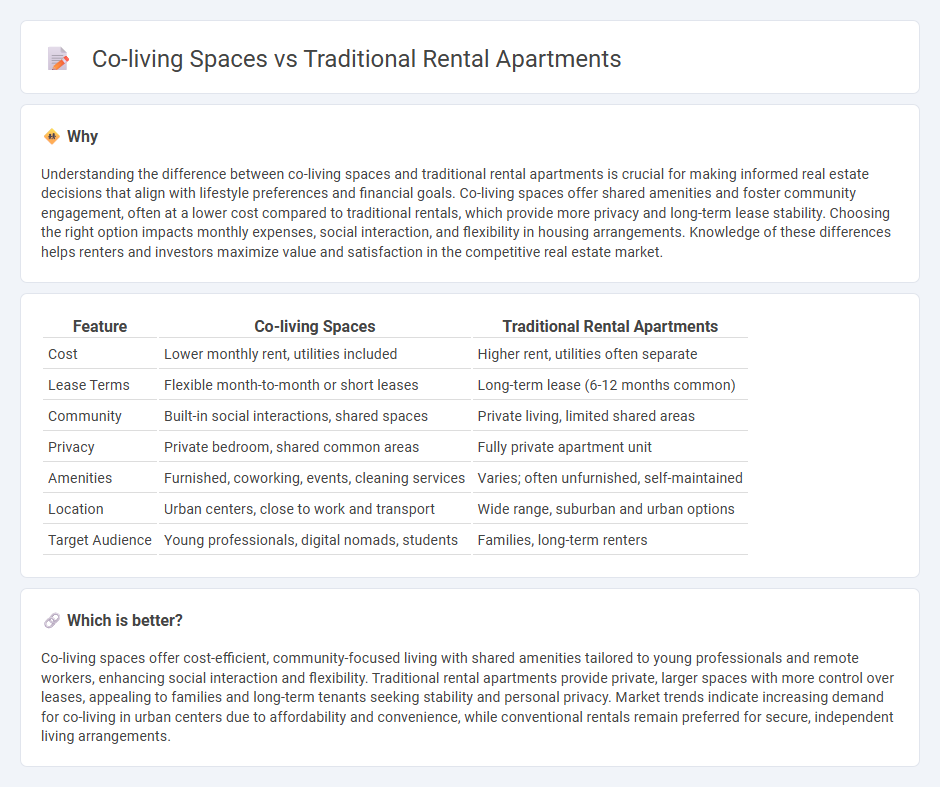
Co-living spaces offer shared amenities and community-focused living with flexible lease terms, contrasting with traditional rental apartments that provide private units and longer, fixed leases. This trend appeals to young professionals and digital nomads seeking affordability and social interaction, while traditional apartments remain preferred by families desiring privacy and stability. Explore the benefits and drawbacks of both options to determine the best fit for your lifestyle and investment goals.
Why it is important
Understanding the difference between co-living spaces and traditional rental apartments is crucial for making informed real estate decisions that align with lifestyle preferences and financial goals. Co-living spaces offer shared amenities and foster community engagement, often at a lower cost compared to traditional rentals, which provide more privacy and long-term lease stability. Choosing the right option impacts monthly expenses, social interaction, and flexibility in housing arrangements. Knowledge of these differences helps renters and investors maximize value and satisfaction in the competitive real estate market.
Comparison Table
| Feature | Co-living Spaces | Traditional Rental Apartments |
|---|---|---|
| Cost | Lower monthly rent, utilities included | Higher rent, utilities often separate |
| Lease Terms | Flexible month-to-month or short leases | Long-term lease (6-12 months common) |
| Community | Built-in social interactions, shared spaces | Private living, limited shared areas |
| Privacy | Private bedroom, shared common areas | Fully private apartment unit |
| Amenities | Furnished, coworking, events, cleaning services | Varies; often unfurnished, self-maintained |
| Location | Urban centers, close to work and transport | Wide range, suburban and urban options |
| Target Audience | Young professionals, digital nomads, students | Families, long-term renters |
Which is better?
Co-living spaces offer cost-efficient, community-focused living with shared amenities tailored to young professionals and remote workers, enhancing social interaction and flexibility. Traditional rental apartments provide private, larger spaces with more control over leases, appealing to families and long-term tenants seeking stability and personal privacy. Market trends indicate increasing demand for co-living in urban centers due to affordability and convenience, while conventional rentals remain preferred for secure, independent living arrangements.
Connection
Co-living spaces and traditional rental apartments share the fundamental goal of providing residential housing, catering to tenants seeking flexibility and affordability. Both options occupy segments within the broader real estate rental market, influencing urban housing supply and demand dynamics. Real estate developers and investors analyze trends in co-living adoption and traditional apartment occupancy rates to strategize portfolio diversification.
Key Terms
Lease Structure
Traditional rental apartments often require long-term leases ranging from 12 to 24 months, with fixed monthly rent and individual tenant responsibility for utilities. Co-living spaces, in contrast, typically offer flexible lease terms including month-to-month or short-term options, with rent covering utilities, amenities, and community events, promoting cost predictability and social engagement. Explore more about how different lease structures influence your living experience and financial planning in evolving housing markets.
Shared Amenities
Traditional rental apartments typically offer private amenities, limiting social interaction and shared experiences among residents. Co-living spaces emphasize shared amenities such as communal kitchens, lounges, and coworking areas, fostering community engagement and cost efficiency. Explore how shared amenities in co-living spaces enhance lifestyle and affordability.
Privacy
Traditional rental apartments offer a higher level of privacy with private entrances, individual bedrooms, and personal living spaces, making them ideal for those valuing solitude and independence. Co-living spaces provide a community-oriented environment where shared amenities and common areas encourage social interaction but often at the expense of personal privacy. Explore the unique privacy features of each living arrangement to determine which best suits your lifestyle needs.
Source and External Links
Apartment - Wikipedia - This webpage provides comprehensive information about apartments, including different names used in various English-speaking countries and types of housing tenure.
Different Types of Apartments - Allstate - This resource offers a detailed guide to various types of apartments, including studio, alcove studio, mid-rise, low-rise, and walk-up units.
Palm Lake Village Apartments - Provides information about traditional and remodeled apartments in Pinellas County, including rent prices and eligibility criteria.
 dowidth.com
dowidth.com